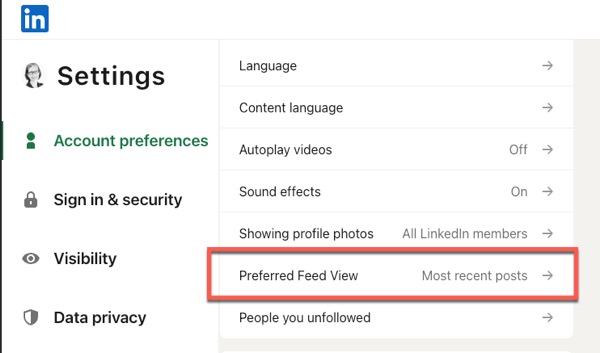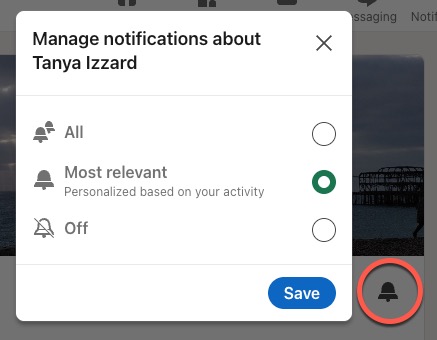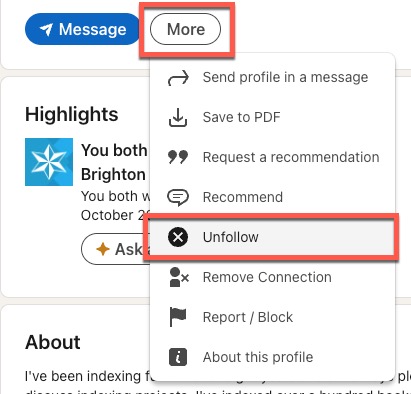When I talk to academics about LinkedIn, the most common word I hear is “grubby,” swiftly followed by “timesink”. Although networking is vital for most of us, these platforms are designed to keep us clicking like eejits all day long. You don’t get funding for reaching an impressive number of likes, and it’s easy to lose half a day when you intended to spend just five minutes.
In this post, I’ll explain some tactics for making the most of LinkedIn without letting it gobble up your precious time or your soul.
1. Be clear on your intention
Before spending any time at all on LinkedIn, consider what you’re hoping to achieve with it. What’s your mission?
Firstly, who are you trying to reach? Employers, funders, collaborators, participants, publishers, policy makers?
Secondly, what do you want to be known for?
- Solving a specific problem?
- Representing/championing a community?
- Raising awareness?
- Public engagement?
- Widening participation?
Maybe you have multiple targets, but what’s the main one right now? The advantage of a LinkedIn profile is that you can change it at any time to emphasise the content that best supports your current aim.
If you pursue one clear aim at a time, it’s easier to measure whether you’re making progress.
Once you know your answer, you can shape your profile headline, About section, and featured content to support that aim.
👉 See What Should You Include in Your Academic LinkedIn profile?
2. Start simple
Creating a LinkedIn profile is an iterative process - you can’t just set it and forget it. Start with a basic profile, then gradually extend it in a way that feels comfortable for you.
👉 See What Should You Include in Your Academic LinkedIn profile? for ideas.
You can also use the search feature in LinkedIn to find profiles of similar researchers. As you review their profiles, ask yourself:
- What do you like about their profile?
- What do you dislike or find annoying?
- What elements would work well for your profile?
Keeping your profile up-to-date and relevant is more important than adding lots of content. Make sure you signpost your academic web presence elsewhere, for example your university profile, institutional repository, or ORCID page. You can do this through the websites section in your Contact Info.

3. Make a plan
Rather than thinking, “Hmm, I’ll just pop on LinkedIn for five minutes,” be intentional. Social media platforms are designed to make us lose all sense of time, so use a stopwatch to remind yourself of those self-imposed limits.
You can create a plan like this and then scheduled your activities:
- Once a week: like a few posts, comment on a post, add any new connections. ~5 minutes
- Once a month: make sure your profile is up-to-date, post about any new publications/events/useful resources. ~30 minutes.
- Once a year: review your profile to ensure it still reflects your current interests and aims. ~60 minutes.
This is just an example - adjust the frequency to suit your circumstances and goals.
Also schedule a more substantial review if you’re:
- Applying for funding.
- Applying for a job.
- Submitting a book proposal.
You’ll need to make sure your LinkedIn profile is supporting that specific application or proposal. Think of LinkedIn like your shop window - you get to decide what’s on display so you can entice people in.
4. Be Human
Depending on how you use it, LinkedIn can be like the worst conference you ever attended or the best conversation you’ve had. The most important message it to keep it human. Although there are many third-party tools to help you automate your LinkedIn presence, don’t be tempted. One meaningful relationship is much more valuable than than 500 very loose connections. It’s quality, not quantity.
👉 See How to Build Your Academic Network on LinkedIn
This applies to the content you share, too. One genuinely insightful post each month is better than 25 generic posts. Before posting, ask yourself: is this something I’d want to read? Again, avoid using AI to create or edit your posts. People want to connect with other humans, not with bots.
💡 For more content ideas, see What Should You Post on Academic LinkedIn?
5. Improve Relevance
In addition to being mindful about what you post, also pay attention to what you’re consuming. Content overload leaves us exhausted and unable to identify the signal amid the noise. Even if other people in your network are chasing the LinkedIn algorithm and posting every two minutes, you can tune out. Here are some ideas to help you.
Change your feed settings
By default, the LinkedIn algorithm decides what you should see in your feed. Sometimes this is helpful, as you’ll learn about a hot discussion in your field. Less helpfully, though, LinkedIn often surfaces out-of-date posts about past events or hides posts from people you want to hear from.
Under Settings > Account Preferences, you can choose between 1) Most relevant posts or 2) Most recent posts. Naturally, it’s LinkedIn who decides what’s most relevant. As they explain:
The first option means LinkedIn will use data from your profile and activity to rank feed content based on your interests. The second option means LinkedIn won’t use your profile and activity data, and instead show content in reverse chronological order.
You can change this setting at any time, so it’s worth experimenting to see whether it improves the quality of your feed.

Set alerts on important people
If posts from important people are getting buried in your feed, consider setting an alert. Click the bell icon in the top right corner of their profile. You can choose whether you want to be notified about all updates, or just the most relevant. Unless they’re a prolific poster, you might choose “all” so you don’t miss anything.

Unfollow anyone who’s not adding value
As LinkedIn is about maintaining relationships, you might feel uncomfortable about removing your connection from annoying people. Happily, you can unfollow them instead. That way, you maintain the connection, but no longer see their endless posts in your feed. Better still, they don’t know you’ve unfollowed them.
To unfollow a LinkedIn connection, click the More button at the top of their profile, then click Unfollow.

You can find a list of people you unfollowed in your Account preferences. You could review your virtual naughty step every so often to see if anybody has calmed down and deserves another chance.
Above all, consider who you really want to be part of your network and how much you want to interact with them.
👉 See How to Build Your Academic Network on LinkedIn
Conclusion
Ignore posts that scream, “You’re doing LinkedIn all wrong! Here’s how to win.” There’s no magic formula. Yes, it takes time to devise your own approach, but that’s going to save you many hours in the meantime. Remember:
- LinkedIn should be working for you, not the other way around.
- Don’t feel guilty about unfollowing people if they’re not adding value.
- Take breaks (LinkedIn isn’t your job).
And, of course, you’re measured on your research, not how many likes you get.
This guide is part of a four-part LinkedIn series for academics. You can find detailed guidance on creating your profile, what to post, and building your network in the resources for my workshop on Creating a Strong Academic LinkedIn Profile.